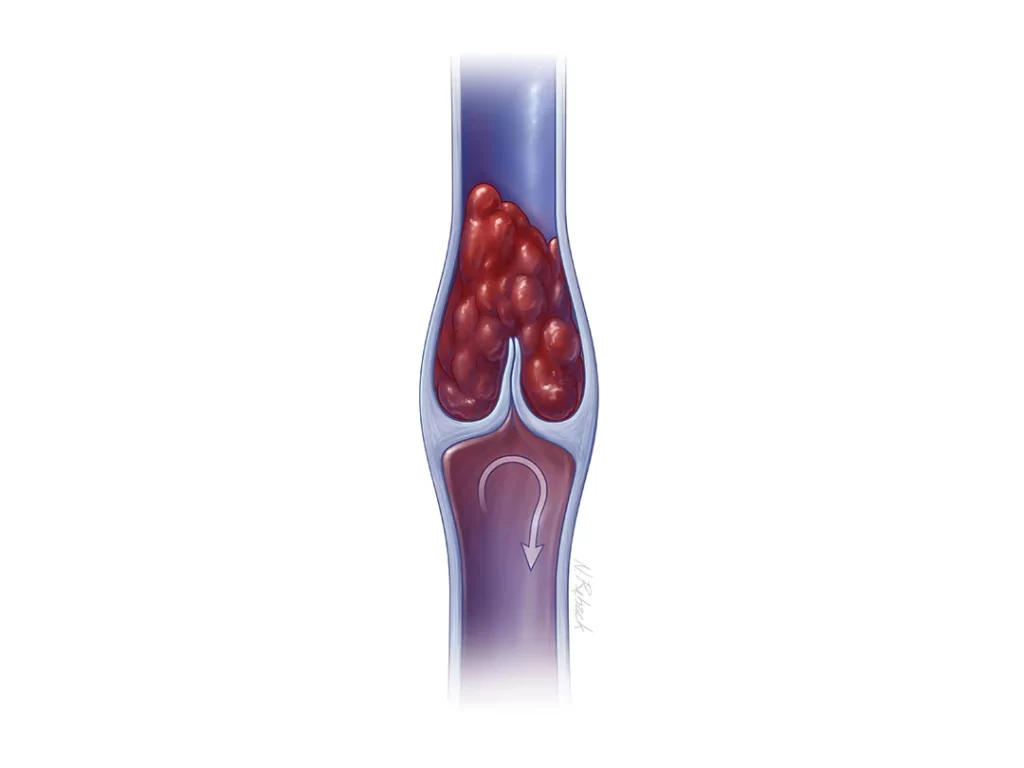Deep Vein Thrombosis (DVT) is a blood clot that usually forms in the deep veins of the lower leg or arm which can block thevenous return. A DVT may cause leg pain or swelling, but can also present no symptoms. DVT is not usually life threatening, but it can be if the blood clot breaks loose and embolizes into the lungs. This is known as a pulmonary embolism (PE).
Generally, a DVT is caused by a combination of two out of three underlying conditions:
- Slow or sluggish blood flow through a major vein,
- A tendency for a person’s blood to clot quickly, a condition that sometimes is hereditary,
- Irritation, inflammation or damage of the lining surface of the vein.
 DVT risk factors
DVT risk factors
- History of previous DVT or superficial venous thrombosis
- Prolonged sitting or restricted mobility such as long distance travel
- Age over 40
- Surgery (especially orthopedic) or major injury
- Prolonged bed rest or immobility
- High blood pressure
- Heart attack or stroke
- Congestive heart failure
- Chronic respiratory failure
- Excessive weight
- Sedentary lifestyle
- Smoking
- Varicose veins
- High oestrogen levels such as in pregnancy or when using birth control pills
- Some forms of cancer
The risk factors are cumulative – the more you have, the greater your risk.
DVT symptoms
Leg pain and hardness of the calf. The calf’s pain may cause walking to be difficult.
A feeling of heat, a slightly blue or red aspect of the skin may also be observed
Acute swelling of the calf or whole leg (in most cases unilateral)
However, nearly 50% of all DVT cases have no recognized symptoms!
Diagnosis
When symptoms described above occur, you must go see a doctor quickly in order to confirm or to rule out the diagnosis which can be made with a simple ultrasound scan that is painless and risk-free. A specific blood test may be performed to measure “D-dimer” which is a sign of recent clotting. Early diagnosis and treatment greatly reduces the risk of serious complications.
Complications of a DVT
Nearly 30% of DVT patients will have a recurrent event within 10 years with the greatest risk within the first 6 to 12 months. (Source: Heit J, et Al. Arch Internal Medicine 2000.160: 761-768.)
Pulmonary embolism (PE) is another complication of a DVT. It occurs when the blood clot, or part of it (emboli), detaches itself and migrates to the pulmonary arteries in the lungs. Most patients with a DVT have an unrecognized pulmonary embolism. The search for its presence is not mandatory as treatment of DVT and asymptomatic pulmonary embolism is the same. Symptomatic pulmonary embolism is the most serious consequence of DVT because it may be fatal.
Tips to prevent DVT
- Exercise regularly, including stretching and leg movement when traveling
- Quit smoking
- Maintain a normal body weight
- Keep a healthy diet
- Wear SIGVARIS compression socks or stockings especially in risky situations like long lasting travel or immobilization
Benefits of compression therapy
According to Brandjes DP et. Al. Lancet 1997 and the American Public Health Association White Paper, the risk of developing post-thrombotic syndrome including leg swelling, pain and venous ulcers after DVT is reduced by as much as 50% when wearing medical compression stockings.
Wearing SIGVARIS graduated compression stockings helps reducing the risk of DVT by improving the venous blood return. SIGVARIS prides itself in providing products that deliver a comfortable fit and the compression strength recommended by your physician.
Deep vein thrombosis: SIGVARIS solutions
The treatment of a deep venous thrombosis will consist of taking anticoagulant drugs and wearing 20 to 30 mmHg SIGVARIS medical compression stockings. This will eliminate the symptoms rapidly and durably and allow to stay mobile and pursue every day activities. Both components of the treatment will last for several weeks or months. Compression therapy is the application of controlled graduated external pressure to the limb to reduce venous pressure within the limb. This external pressure acts as a layer of muscle by gently squeezing the stretched vein walls together allowing the valves to close. The cavity of the vein is reduced, thereby restoring blood flow to a normal state and aiding overall circulation.
SIGVARIS medical compression stockings provide relief from pain and swelling caused by a DVT. Physicians recommend wearing 30-40 mmHg compression stockings for at least 2 years after the initial DVT diagnosis. By doing so, the risk of developing another clot is reduced by as much as 50%. Source: Brandjes DP, et. Al. Lancet 1997.
Please note the difference between TEDS (Anti-Embolic Stockings) and graduated compression stocking: TEDS are designed to prevent DVT in people who are in a recumbent (horizontal) position for a long period of time, as one of the risk factors for DVT is long periods of immobilization following surgery. For ambulatory patients, graduated compression stockings should be worn.
SIGVARIS provides several ranges of compression therapy products that deliver efficacy, comfort and style in the compression strength recommended by your doctor.
Depending on the country or area of the world, the SIGVARIS product offering is different to reflect the specificities of each market. To find out about the SIGVARIS product in your country visit your countries SIGVARIS-website.
